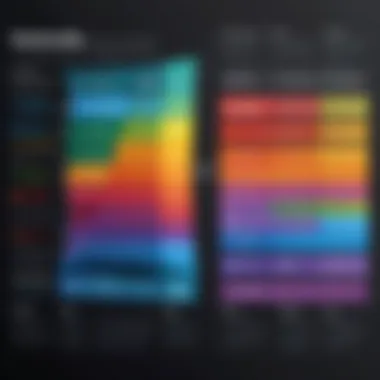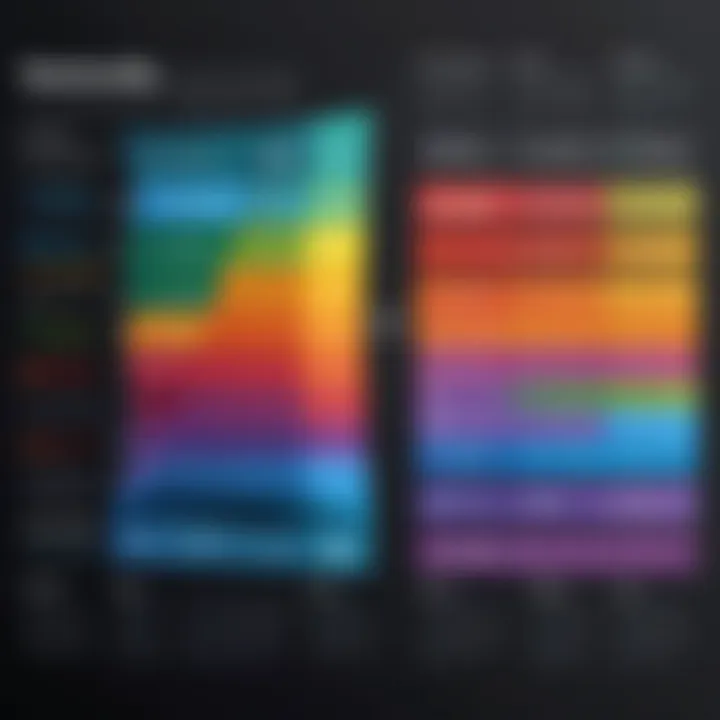Understanding Predictable Irrationality in Decision-Making


Intro
In a world where choices abound and information flows faster than the blink of an eye, understanding how we make decisions is more crucial than ever. The insights from Dan Ariely shed light on the quirks of human behavior, unveiling a landscape where rational and irrational blend seamlessly. His work in behavioral economics challenges our perceptions of decision-making, encouraging us to question the frameworks through which we interpret our choices.
Behavior is often dictated by biases, subconscious triggers, and the intricate dance of logical reasoning and emotion. Emphasizing the idea of predictable irrationality, Ariely posits that our decision-making is not as erratic as one might think; rather, there are discernible patterns — rules of the game, if you will, that often lead us astray.
This article aims to unpack these fascinating concepts, providing a comprehensive look at Ariely's theories and their implications across various domains. From consumer behavior to our daily interactions in society, the impact of predictable irrationality is profound and far-reaching.
Technology Insights
As we navigate the tech landscape, the influence of predictable irrationality becomes apparent. Decision-making processes in technology can often be non-linear, attuning to the motivations and cognitive biases of users. A prime example is the realm of user experience (UX) design, where understanding behavioral tendencies can significantly enhance product effectiveness.
Latest Tech Trends
In the ever-evolving sphere of technology, trends like personalization and artificial intelligence are intricately linked to human behavior. Companies are utilizing data analytics to tailor experiences, tapping into our biases to steer user preferences. For instance, a platform's homepage might display content that aligns with our past interactions, ensuring that we continue to engage. This deliberate design, while seemingly benign, plays a role in how users consume information.
Innovation in Tech
Innovators today are leveraging insights from behavioral economics to develop solutions that resonate deeply with users. Companies are not just creating products; they are sculpting experiences. Through A/B testing and feedback loops, tech firms like Spotify and Netflix optimize their algorithms to predict and enhance user satisfaction. The nuance of Ariely's work informs these advancements, suggesting that users stick around not simply for the service but for the emotional connection prompted by these tailored interactions.
Product Reviews
Take for instance the newest smartphone from Apple — the iPhone 15. While many focus on specs, the allure often lies in the narrative woven around the brand. The status and desirability associated with owning the latest device are rooted in cognitive biases that Ariely explores. Thus, the iPhone is more than just a product; it serves as a symbol, an emotional anchor in its users' lives, demonstrating how predictable irrationality influences purchasing decisions far beyond practical considerations.
"Understanding the cognitive frameworks that dictate our decisions can illuminate the paths we choose in technology and beyond."
As we continue this exploration of predictable irrationality, it’s essential to recognize how Ariely's insights bridge the gap between abstract theory and real-world application, especially in technology. The interplay of our preferences and biases sets a course that isn't merely random but instead surprisingly predictable.
Understanding Predictable Irrationality
In a world overflowing with information and choices, understanding predictable irrationality is paramount. This concept exposes the peculiarities of human behavior, showing that our decisions are often guided by underlying biases rather than pure rational thought. In this article, we delve into this fascinating realm, where intuition and emotion frequently overshadow logical reasoning.
When we dissect the idea of predictable irrationality, we unveil a treasure trove of insights that reveal how people think and act in ways that can appear illogical on the surface. This understanding equips individuals and organizations alike to navigate the complexities of decision-making, enhancing strategies that cater to human behavior. By recognizing these predictable patterns, marketers, designers, and policymakers can better influence choices and outcomes in their respective fields, ultimately leading to more effective communication and user engagement.
Defining the Concept
To define predictable irrationality, one must consider how humans often stray from logical decision-making. Instead of acting purely on facts and figures, our choices are tinted by emotions, experiences, and cognitive shortcuts, resulting in what Dan Ariely elegantly illustrated in his work. Suppose a person spends extra time evaluating a product priced at $100, even when similar alternatives exist for $80. This isn't just frugality; it highlights the intricate dance between value perception and emotional influence, often leading to seemingly irrational choices.
By understanding this concept, it becomes clear that decision-making is not a straightforward process; it's a mosaic of psychological factors that can produce predictable yet irrational outcomes.
Historical Context and Development
The historical roots of predictable irrationality delve into the evolution of behavioral economics. Before pioneers like Ariely, the field was largely dominated by traditional economic theories, which posited that individuals behave rationally, optimizing their decisions for the best outcomes. However, as real-world observations began to contradict these theories, scholars started to investigate how psychological elements influence economic behavior.
Ariely's experiments emerged as a breath of fresh air, bringing light to the quirks of human nature. For instance, through his seminal studies such as the "decoy effect," he illustrated how the presence of a less attractive option could steer decisions towards a preferred choice. This line of inquiry opened the floodgates for a deeper understanding of irrationality in economic contexts.
In tracing the steps from classical economic assumptions to a more nuanced appreciation of human behavior, one notes a critical shift. Experiments based on everyday scenarios revealed that individuals do not always act in their best interests when given the chance, reinforcing the importance of recognizing and understanding our predictable irrational behaviors.
"Understanding predictable irrationality allows us to navigate our choices better and make informed decisions, even when our instincts may lead us astray."
By integrating these insights from history into contemporary applications today, we arm ourselves with the knowledge to make sense of the unpredictable nature of decision-making. Given the rapid pace of technological advancements, these findings have never been more relevant, shaping how industries approach their strategies and how individuals assess their own choices.
The Role of Behavioral Economics
Behavioral economics is a pivotal field that marries insights from psychology with the economic theory. This blend shifts the traditional understanding of economics, which often assumes that people are rational agents always making decisions in their best interest. Instead, Ariely's work highlights that human beings frequently operate based on a complex mix of emotions, societal influences, and individual biases. This perspective challenges the one-size-fits-all assumptions about economic choices, asserting that these decisions are often far from rational.
By examining the subtleties of human behavior, behavioral economics opens up new avenues to comprehend how people navigate their choices. This understanding is vital not only for scholars but also for practitioners in various fields, from marketing to public policy. Insights drawn from behavioral economics can illuminate the often unpredictable paths individuals take, revealing a wealth of patterns that can be strategically utilized.
Key Principles of Behavioral Economics
A few principles stand out when discussing behavioral economics:
- Bounded Rationality: This concept suggests that while individuals aspire to make rational decisions, their capacity is limited by the information they have at hand and their cognitive capabilities. Thereby, real-life decisions often straddle the line between rationality and irrationality.
- Framing Effects: The way information is presented greatly influences decision-making. For instance, stating that a product is '90% fat-free' can lead to more favorable perceptions than saying it contains '10% fat', highlighting how context can skew understanding.
- Social Norms: Humans are inherently social beings. Therefore, understanding how individuals fall in line with societal expectations can provide profound insights into their behaviors. For example, marketing strategies that leverage peer influence tend to be more successful.
These principles not only provide clarity into human behavior but also carve pathways for innovation in sectors ranging from tech to public health.
Contrasting Traditional Economic Models
Traditional economic models often rely on the notion of the 'homo economicus' — the idea that people act in a purely self-interested, rational manner. However, this perspective fails to encapsulate the full picture of human behavior. Exploring contrasts between traditional economic models and behavioral economics reveals significant gaps.
- Assumption of Rationality: Traditional models assume that individuals have complete information and a meticulous approach to decision-making. Behavioral economics, however, highlights that people often operate on heuristics or mental shortcuts, which can lead to systematic errors in judgment.
- Emotional Influences: Traditional theories often downplay emotions' role in economic decisions. Ariely’s experiments underscore the significant impact of emotional factors on decision-making processes, demonstrating that feelings often drive choices more than logical reasoning does.
- Predictability of Behavior: Traditional models view economic choices as random and unpredictable. In contrast, behavioral economics implies that human irrationality, while seemingly chaotic, follows recognizable patterns and trends that can be studied and anticipated.


"Behavioral economics redefines the playing field, moving from the prescriptive to the descriptive, thus allowing us to better understand and shape human behavior rather than merely predicting it."
The contrasting perspectives presented by behavioral economics ultimately shape a more accurate and realistic view of decision-making, driving home the point that understanding human behavior is essential in designing better tools, services, and policies that align with how people actually think and behave.
Cognitive Biases and Their Impact
Cognitive biases play a critical role in understanding decision-making. These are systematic patterns of deviation from norm or rationality in judgment. In the context of Dan Ariely's work, examining the impact of these biases opens up a vital dialogue about our predictably irrational behaviors. By dissecting cognitive biases, this article provides insights that not only clarify why people make certain choices but also reveal how these decisions can be influenced by various external factors. Effectively analyzing these biases brings to light how individuals operate in everyday scenarios, from shopping habits to workplace dynamics.
Understanding these biases helps to better grasp the overall patterns of human behavior and can be especially useful in a technology-driven world where data and behavioral predictions shape innovations. It's important for a tech-savvy audience to recognize that their decisions, often made in haste, are frequently nudged by invisible forces.
Types of Cognitive Biases
Anchoring Effect
The Anchoring Effect is an interesting bias. It indicates that people rely too much on the first piece of information they encounter when making decisions. For instance, if a smartphone is initially priced at $1,000 and then is offered at $800, the initial price serves as an anchor. This bias makes the $800 price tag seem like a steal, even if it may still be too high compared to competing models.
The key characteristic of the Anchoring Effect is its profound influence on decision-making processes. In this article, its relevance comes from highlighting how the initial information can distort judgment. A unique advantage is understanding how marketers can leverage such anchors to steer consumer choices, although a disadvantage is the potential to overpay for products simply because of a misleading starting price.
Loss Aversion
Loss aversion holds that individuals prefer to avoid losses rather than acquire equivalent gains. This principle is so powerful that the pain of losing $100 is felt more intensely than the pleasure of gaining the same amount. It's pivotal in explaining why people might avoid high-risk investments despite potentially lucrative returns.
In this article, the focus on loss aversion demonstrates a strong emotional component in decision-making. Highlighting this bias can help tech entrepreneurs craft better user experiences, ensuring that offerings resonate emotionally and reduce the fear of loss associated with change. A notable feature is its widespread applicability, albeit the downside lies in its capacity to hinder innovation by making people overly cautious.
Confirmation Bias
Confirmation bias is another core aspect to scrutinize. It’s the tendency to search for, interpret, and remember information in a way that confirms one’s preexisting beliefs. When emerging technologies are in play, users often look for data that validates their choices, neglecting conflicting evidence that could offer a more balanced view.
The key characteristic of this bias lies in the selective nature of human thought, which shapes perceptions in a way that reinforces what one already believes. In terms of applications for this article, it's a beneficial choice since it reflects how tech-savvy individuals may fall into traps when adopting new technologies or gadgets. A unique aspect of confirmation bias is its ability to create echo chambers, which may harm informed decision-making, leading to significant gaps in knowledge.
Case Studies Illustrating Biases
To further illustrate these biases, we can look at case studies drawn from behavioral economics research and real-world user experiences.
- Case Study on Anchoring
A study featuring pricing strategies in retail highlights how initial pricing on a sneaker line anchored consumer expectations. Participants reported a higher willingness to pay if they first encountered a high anchor, reinforcing the notion that anchors distort perceived value. - Case Study on Loss Aversion
In another example, participants were more likely to protect a small amount of invested money in a tech startup than to invest additional amounts in promising technologies. This behavior underscores loss aversion’s weight in risk assessment and projected outcomes. - Case Study on Confirmation Bias
An investigation into social media platforms shows how users preferred to share articles that aligned with their political views, indicating how confirmation bias can impact discourse and tech-driven user interactions.
These case studies reveal the complexity behind cognitive biases while adeptly supporting the article’s rationale. By mapping biases to concrete scenarios, readers can better appreciate their influence, perhaps prompting introspection about their own decision-making habits.
Ariely's Experiments and Findings
Dan Ariely's work profoundly reshapes our understanding of human decision-making. Through a series of well-designed experiments, he sheds light on the systematic ways we often fall short of rationality, despite believing otherwise. In this section, we will dissect the importance of these experiments, focusing on their distinctive elements, the benefits they present in everyday scenarios, and the valuable insights they provide into human behavior.
Key Experiments Overview
Ariely's experiments are crafted with a unique flair for revealing the quirks of human nature. One of his hallmark studies involves the pricing of decoy options. In a classic setup, participants were asked to choose between various subscription packages for a magazine. The introduction of an intentionally unattractive option, or decoy, significantly influenced the choices of the participants. This experiment illustrates not only the role of contextual cues but also how seemingly irrelevant information can subtly steer decisions.
Another notable experiment centered on the concept of free, or nearly free, offers. Participants faced choices involving a high-priced gourmet chocolate and a low-priced Hershey's kiss. When Ariely presented these options, the majority opted for the higher-priced chocolate as the price difference was minimized. This finding underscores how the allure of something free can overshadow rational evaluation of value.
Ariely's work doesn't stop at consumer behavior; it delves into the ethical dimensions of decision-making. In one experiment, he explored the effects of moral reminders on cheating. College students were asked to self-report their scores on a mundane test while being subtly reminded of their moral values. The findings indicated that when values were invoked, the levels of cheating dropped noticeably. This points to a fascinating interplay between conscious reflection and decision integrity.
Analysis of Results
The results from Ariely’s experiments are not merely academic; they present real-world implications. The decoy effect serves as a powerful reminder that our choices can be engineered by external factors. Understanding this can lead to smarter consumer habits, as individuals become more aware of how advertisements and pricing structures can manipulate their behavior.
Moreover, the attraction to free goods illustrates a common occurrence in everyday life. Consider how promotional strategies often rely on the allure of free samples or limited-time offers. Recognizing the underlying psychological framework enables businesses to craft better marketing approaches and encourages consumers to critically assess true value rather than succumb to frail instincts.
The insights on ethical behavior raise pivotal questions about personal and public morals. The experiments suggest that even small reminders can nudge individuals toward more ethical choices. This notion could revolutionize how organizations approach integrity in various contexts, from education to corporate environments.
Overall, Ariely's experiments underline the complexity of predictable irrationality. They encourage a deeper dive into why we choose what we choose, revealing layers of reasoning that often go unnoticed in our daily lives. As technology continues to permeate decision-making processes, understanding these behavioral nuances becomes increasingly vital for both consumers and corporations alike.
"The narrative of our choices is interwoven with our biases, making every decision a dance between intention and influence."
In summary, Ariely's work does not just unveil the quirks of our choices; it offers a toolkit for navigating the complexities of the modern decision-making landscape. Understanding his findings isn’t just for academic curiosity; it’s crucial for anyone looking to decipher the subtleties of human behavior in an ever-evolving technological world.
Applications of Predictable Irrationality
Understanding the applications of predictable irrationality is vital, as it underscores how human behavior deviates from traditional economic assumptions. This section delves into two core areas where these principles manifest: consumer behavior and marketing strategies. Both areas provide an insightful lens to evaluate irrational choices, showing how they can be harnessed to better meet consumer needs and enhance business efficacy. Recognizing how predictable irrationality plays out in real-world scenarios gives companies a leg up in crafting more impactful offerings and messages.
In Consumer Behavior
Human decision-making often appears haphazard, driven by a mix of cognitive biases and emotional responses. When it comes to consumer choices, these factors can heavily influence purchasing habits. For instance, consider the concept of loss aversion, where individuals would rather avoid losses than acquire equivalent gains. This explains why a limited-time offer has an enticing lure; the fear of missing out often outweighs the rational analysis of the deal's value.


Factors influencing consumer behavior through the lens of predictable irrationality include:
- Anchoring: This effect suggests initial information biases future decisions. For example, displaying a high original price next to a discounted price makes consumers perceive the discount as a significant benefit.
- Social Proof: People often judge the value of a product based on its popularity. The mere presence of reviews or ratings can sway purchasing decisions.
- Choice Overload: While consumer choice is often deemed positive, too many options can lead to decision paralysis. Simplifying choices can often result in more effective selection processes and greater satisfaction.
These insights demonstrate that while consumers may operate under the veil of rational decision-making, their choices are often far from it. Companies can better cater to their audience by acknowledging these underlying behavioral patterns.
Implications for Marketing Strategies
Marketers are increasingly recognizing the significance of predictable irrationality in shaping their strategies. Rather than adhering strictly to conventional approaches, there is a growing emphasis on understanding psychological triggers that drive consumer responses. It’s about playing the game of human emotions rather than just presenting facts.
Consider the approach of utilizing FOMO (Fear Of Missing Out) in marketing campaigns, which exemplifies the role of loss aversion as consumers feel compelled to act quickly. This strategy highlights making limited editions or exclusive offers.
Here are a few strategies grounded in predictable irrationality that marketers are deploying:
- Creating Urgency: Using countdown timers or stock indicators fosters a sense of urgency that plays into impulsive buying habits.
- Leveraging Scarcity: Phrases like “Only a few left!” can drive purchases by tapping into the fear of missing out.
- Framing Techniques: Presenting information in a favorable light can decisively influence perceptions. For instance, using phrases like "90% of users find our product beneficial" rather than stating that "10% don’t find it beneficial".
“Understanding consumer behavior through the lens of predictable irrationality helps bridge the gap between what people think they want and what they actually need.”
By reframing marketing narratives to resonate with predictable irrationality, businesses can not only increase consumer engagement but can also forge stronger connections with their audience. In today’s competitive landscape, leveraging these insights becomes not just advantageous but essential.
Through these strategies and observations, it is evident that predictable irrationality shapes the marketplace in profound ways. Recognizing and integrating these patterns into both consumer behavior analysis and marketing strategies leads to more effective outcomes for all stakeholders.
Predictable Irrationality in Technology
In today’s fast-paced digital world, understanding predictable irrationality is essential. It shapes how users interact with technology, guides the design of digital products, and influences decision-making processes. Acknowledging these behaviors can lead to better user experiences and more effective tech solutions.
When we talk about predictable irrationality in technology, we are looking at the patterns and biases that guide our tech interactions, often subconsciously. This topic is not just for academic scrutiny; it has real-world implications—enhancing usability, optimizing design, and ultimately shaping the way technologies fulfill our needs.
Key considerations include:
- Understanding user behavior to create optimized interfaces.
- Leveraging cognitive biases to improve layout and navigation.
- Designing systems that accommodate irrational decision-making, rather than expecting purely rational behavior.
As we dive deeper into the complexities of user interface design and the decision-making formats in tech environments, we can unlock the potential of technology in more meaningful ways.
User Interface Design
User interface design is the front line of interaction between users and technology. A well-crafted interface can make complex systems approachable. On the contrary, a poorly designed interface might frustrate users, forcing them to abandon a product altogether. Research in predictable irrationality suggests that people don’t always follow the logical path we might expect.
- Design Elements to Foster Engagement:
- Colors and Layouts: Bright colors may draw users in, while a balanced structure makes navigation intuitive.
- Feedback Mechanisms: Immediate responses to actions (like clicks or swipes) reassure users they are on the right track.
- Simplicity Over Complexity: Reducing the cognitive load can prevent decision fatigue, ultimately guiding users to desired outcomes.
Consider the example of mobile app design. When an app offers an easy-to-navigate structure, users are less likely to second-guess their choices, minimizing the impact of biases like indecision or loss aversion. If users find themselves mired in an overly complex design, their motivation to engage diminishes significantly.
Impacts on Decision-Making in Tech Environments
In tech environments, decisions often carry weight—whether selecting a product to buy, signing up for a service, or choosing how to use a feature. Alas, those choices are frequently not made through logical reasoning; instead, predictable irrationality can cascade through these processes.
- Factors That Influence Tech Decision-Making:
- Default Options: Users often select pre-set options without considering alternatives, a manifestation of the default bias. This effect underscores the power of choice architecture in software.
- Social Proof: Many people are swayed by what others do. If a coding platform displays how many users are engaged, newcomers may feel pressured to jump in without their due diligence.
- Time Constraints: The urgency of a time-limited offer can spur hasty decisions, demonstrating how irrationality creeps into choices under stress
"Users do not just want to choose. They want to feel good about their choices, even if those choices aren't rational."
Taking these elements into account can significantly enhance user retention and satisfaction. In an era where technology is at the heart of every interaction, leveraging our understanding of predictable irrationality facilitates better design choices and ultimately leads to a more engaged user base.
Societal Implications of Irrational Behavior
Understanding the societal implications of irrational behavior is crucial in the context of behavioral economics. Dan Ariely's work unveils the ways in which irrational decisions intersect with larger societal structures and influence public policy, economic stability, and social dynamics. The implications stretch far beyond individual choices, reverberating through entire communities and shaping the very fabric of society.
Economic Policies and Public Decision Making
When examining the impact of predictable irrationality on economic policies, one cannot overlook how deeply entrenched cognitive biases can skew public decision making. For instance, policymakers often fall prey to loss aversion—a tendency to prioritize avoiding losses over acquiring equivalent gains. This can lead to hesitant stances on reforms and funding that might yield long-term benefits but risk immediate losses, however small.
The reality is that many economic policies are formulated with a one-size-fits-all mentality, disregarding the nuanced behavioral realities faced by different groups. A prime example is the approach to taxation; when tax incentives are introduced without consideration of how individuals perceive value, the intended effects often drift into chaos. Policies may end up being unpopular or ineffective simply because they do not align with citizens’ irrational inclinations.
Furthermore, public reaction to economic downturns can reveal a collective tendency toward fear-driven decision making. Historical events, such as the 2008 financial crisis, demonstrate how panic can lead to irrational fiscal policies and knee-jerk reactions that may exacerbate rather than alleviate economic woes. Reflections on these patterns highlight a need for engaging strategies that account for human behavior's intrinsic unpredictability.
Ethical Considerations
The ethical implications of predictable irrationality cannot be overstated. As decision-makers grapple with understanding this complex landscape, questions around the responsibility of those in power arise. Are policymakers justified in nudging public behavior in a way that accounts for irrational tendencies, or does this border on manipulation? Such considerations invoke the delicate balance between guiding citizens towards beneficial choices and respecting their autonomy.


Moreover, it raises ethical dilemmas about transparency in policy formulation. For example, when accidental misinformation or skewed framing might lead to irrational public responses, it places an onus on leaders to ensure clarity and accuracy. Citizens should not feel like pawns in a game where their understanding is warped to achieve policy goals.
Most importantly, the ethical footprint of behavioral economics extends to equity in societal benefits. Any policy driven by an acknowledgment of irrational behavior must also guard against exacerbating existing inequalities. When certain groups react differently due to entrenched biases, it becomes crucial to craft approaches that consider these disparities to foster fairer outcomes.
The intersection of cognitive biases and policy decisions ultimately shapes the direction of our society, revealing the profound necessity of ethically sound approaches.
In summary, the societal implications of irrational behavior manifest in various dimensions of public life, significantly influencing economic frameworks, ethical standards, and individual freedoms. The balance between leveraging these insights for the greater good while ensuring fairness remains a delicate task for modern policymakers.
Challenges and Critiques of the Predictability Concept
Delving into the challenges and critiques surrounding predictable irrationality unveils a landscape rich with both apprehensions and insights. This section will discuss why acknowledging these hurdles is essential in understanding human behavior. It’s not merely about highlighting imperfections; it’s about refining theories and enhancing our grasp on decision-making.
Limitations of Research Findings
Research in behavioral economics often hinges on controlled environments. While this provides clarity, it can be a double-edged sword. Real-life settings are fraught with unpredictability. One major critique is that insights drawn from lab experiments may not fully capture the chaotic nature of human decision-making in everyday life. For instance, Dan Ariely’s experiments frequently involve specific contexts or choices, leading some skeptics to wonder if these findings translate seamlessly into varied situations.
In addition to the environmental constraints, there’s also the question of sample sizes and demographic homogeneity. Studies often rely on college students or specific populations. As a result, these findings may not be generalizable to wider demographics. This raises concerns on whether the theories of predictable irrationality apply uniformly across different cultures or age groups. Whether it's the prevalence of loss aversion among teenagers, or a different decision-making process seen in older adults, the nuances of age and experience may color psychological tendencies in ways that existing research hasn’t yet addressed.
So, while Ariely’s work paints a compelling picture of irrational behavior, it may not always provide the full canvas. Researchers increasingly emphasize the importance of diverse study groups and real-world applications to broaden the scope of valid conclusions drawn from behavioral economics.
Alternative Perspectives
Venturing into alternative perspectives offers a refreshing view on irrationality. Critics argue that predictable irrationality is not the only lens through which behavior can be understood. For many, the focus should shift to the role of rationality interwoven with emotional and social influences.
An interesting alternative can be found in the realm of neuroeconomics, which merges insights from neuroscience and economics. This approach digs deeper into how brain activity influences decisions, positing that both rational and emotional responses shape behaviors. For example, a study showing that people could be swayed by emotional triggers, such as a well-crafted advertisement, indicates that not all choices are knee-jerk reactions to cognitive biases. In some instances, decisions made out of empathy or social obligation would contradict the framework of predictable irrationality.
Moreover, there's a growing interest in examining how factors such as peer influence and social norms guide decision-making. This insight underlines the need to consider the fluidity and dynamic nature of our behavior in various contexts. Instead of merely categorizing choices as irrational, one could explore ways in which decisions are rationalized through sociocultural frameworks, thus challenging the traditionally held beliefs about the inherent randomness of human choices.
Ultimately, reconciling these different perspectives can lead to richer interpretations of how predictable irrationality interacts with our day-to-day choices, demanding a broader understanding beyond what's been established through existing literature.
"The beauty of understanding behavior lies not solely in the acknowledgment of irrationality, but also in exploring the myriad factors that contribute to our unique decision-making processes."
Future Directions in Behavioral Research
The realm of behavioral research is ever-evolving, much like the tides shifting along a windswept shore. As our understanding deepens of how and why individuals make decisions, particularly irrational ones, we see new avenues emerging. The importance of exploring future directions in this field cannot be overstated; it provides the groundwork for not just academic inquiry but also practical applications across various sectors. By honing in on these developments, we reflect on key opportunities and challenges that lie ahead.
One of the primary elements to consider is the integration of technology into behavioral research. With the rise of big data and sophisticated analytics, researchers now have unprecedented access to information about human behaviors. This treasure trove of data allows for finer resolutions of behavior patterns and impacts, opening up a multitude of potential applications. For instance, understanding purchasing behaviors through online shopping habits can reshape marketing strategies.
Another critical aspect revolves around personalization. The audience’s background, culture, and personal experiences shape their decisions uniquely. As behavioral research moves forward, the ability to personalize approaches based on these factors will likely become essential. Tailored interventions could significantly improve decision-making processes—think of it as a snugly tailored suit versus a generic one that just doesn't fit quite right.
"In the intricacies of human behavior, the key often lies in the details that most overlook." – Unknown
Emerging Trends
Exploring emerging trends is crucial for anyone immersed in behavioral economics. As technology advances, a few notable trends have begun to surface.
- Digital Behavioral Nudges: These are modifications designed to subtly influence the choices we make online. Whether it’s changing the placement of a button or altering the color of a discount tag, these nudges can significantly sway decisions without compromising the freedom of choice.
- Social Media Influences: Behavioral research is increasingly recognizing the role social media plays in shaping opinions and decisions. The viral nature of information and its emotional undertones can lead to impulsive behaviors, something that was nearly absent in prior research.
- Cross-Cultural Studies: As the world becomes more interconnected, understanding how different cultures perceive and act on irrationality is essential. This trend addresses the variability and nuance in decision-making based on cultural contexts.
These trending elements are essential as they not only enhance our understanding of predictably irrational behavior but also broaden the scope of applications derived from that understanding.
Interdisciplinary Approaches
The complexity of human behavior invites collaboration across various fields—an interdisciplinary approach can provide a more holistic view.
- Psychology and Sociology: By applying psychological principles along with sociological frameworks, we can gain deeper insights into how social dynamics affect individual decision-making. This dual lens can highlight why certain choices resonate more in collective settings.
- Technology and Behavioral Science: As tech continues to integrate into everyday life, pairing it with behavioral insights leads to innovative solutions. For example, wearable devices that monitor stress levels might help identify irrational decision patterns in real-time.
- Economics and Neuroscience: Understanding the neurological underpinnings of our choices can offer unparalleled insights into why we behave irrationally. By studying brain activity during decision-making processes, researchers can attain a clearer picture that complements economic theories.
In summary, future directions in behavioral research hold tremendous promise. By embracing emerging trends and fostering interdisciplinary cooperation, we can inject new life into the understanding of predictable irrationality. As we proceed, the impacts are set to ripple across diverse facets of society and business, fortifying the interplay between reasoning and emotion in shaping human actions.
End
As we reach the end of our exploration into the unpredictable realm of human decision-making, it's crucial to take a moment to reflect on the essence of our findings. The implications of predictable irrationality, as illustrated by Dan Ariely, stretch far beyond academia; they inform everyday choices and influence sectors such as marketing, public policy, and technology design. Understanding the quirks in our thinking allows us to make more informed decisions, both as consumers and as creators of products designed to engage our attention.
Summary of Key Insights
In summary, this article has shed light on several key insights:
- Behavioral Economics: Behavioral economics intertwines psychology with economic theory, revealing why people often act against their best interests.
- Cognitive Biases: With biases like anchoring, confirmation bias, and loss aversion coming into play, our decision-making processes become predictable yet irrational. Comprehending these biases equips individuals to counteract them effectively.
- Real-World Applications: From design principles in tech to consumer behavior, Ariely’s theories demonstrate tangible applications in various fields. Marketers and product designers can capitalize on these insights to create solutions that resonate better with users.
- Ethical Considerations: The ethical ramifications of exploiting human biases urge us to confront morality within behavioral economics. With power comes responsibility, and it becomes vital to consider how knowledge of these biases can lead to the manipulation of choices.
In essence, the exploration of predictable irrationality reveals a landscape rich in insights, urging both consumers and creators to consider the interplay of choice, impact, and ethical responsibility.
Final Thoughts on Human Rationality
The intertwining of rationality and irrationality exposes the complexity of human thought. As we navigate a world densely populated with information and choices, recognizing our bounded rationality can empower us. It allows us to ask not just "Why did I choose this?" but also, "How could I choose differently next time?" With the guidance of thought leaders like Dan Ariely, we can rethink our approach to decision-making, fostering an environment where informed choices reign over impulsive ones.
This journey into predictable irrationality doesn't just rest on the victories of comprehension; it prompts us to build systems that support better decision-making habits. Understanding our irrationality is but the beginning—it's a call to action for us to design lives that acknowledge our human imperfections while striving towards more rational outcomes.
"The greatest obstacle to discovery is not ignorance — it is the illusion of knowledge."
— Daniel J. Boorstin
Thus, as we step into the future, let's champion a merging of insights from behavioral economics with the everyday realities we face, paving pathways toward smarter choices.







